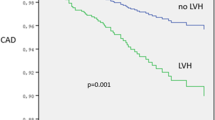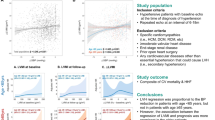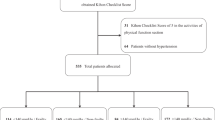Abstract
It has been clearly demonstrated that ageing and arterial hypertension are both associated with an increased prevalence of left ventricular hypertrophy (LVH), which is a powerful risk factor for cardiovascular (CV) events. The objective of this study was to assess the impact of echocardiographic LVH in profiling the absolute CV risk stratification according to the 1999 World Health Organization–International Society of Hypertension (WHO/ISH) guidelines in elderly hypertensive patients. A total of 223 never-treated elderly patients (⩾65 years) with essential hypertension (98 men, 125 women, mean age 72±5 years) referred to our outpatient hospital clinic were included in the study. They underwent the following procedures: (1) medical history, physical examination, and clinic blood pressure; (2) routine blood chemistry and urine analysis and (3) electrocardiogram. The risk was initially stratified according to the routine procedures suggested by WHO/ISH guidelines and subsequently reassessed by adding the results of echocardiography (LVH as left ventricular mass index >51 g/m2.7 in men and >47g/m2.7 in women). According to routine classification, 56% (n=125) were medium-risk patients, 29% (64) high-risk and 15% (34) very-high-risk patients. The overall prevalence of LVH was 56% (48% in medium-risk and 62% in high-risk or very-high-risk patients, P<0.01). A marked change in risk stratification was observed when echocardiographic LVH was taken into consideration: medium-risk patients decreased to 29% and high-risk patients rose to 56% (P<0.01). In conclusion, ultrasound assessment of cardiac target organ damage is extremely useful in obtaining a more valid assessment of global cardiovascular risk in elderly hypertensives, because stratification based on diagnostic routine procedures can underestimate the overall risk in a large fraction (48%) of medium-risk subjects.
This is a preview of subscription content, access via your institution
Access options
Subscribe to this journal
Receive 12 digital issues and online access to articles
$119.00 per year
only $9.92 per issue
Buy this article
- Purchase on Springer Link
- Instant access to full article PDF
Prices may be subject to local taxes which are calculated during checkout

Similar content being viewed by others
References
Collins R et al. Blood pressure, stroke, and coronary heart disease. Part 2: short term reductions in blood pressure overview of randomized drugs trials in their epidemiological context. Lancet 1990; 335: 827–838.
Moser M, Hebert P . Prevention of disease progression, left ventricular hypertrophy and congestive heart failure in hypertension treatment trials. J Am Coll Cardiol 1996; 27: 1224–1218.
Weber MA, Julius S . The challenge of very mild hypertension, should treatment be sooner or later. Am J Hypertens 1998; 11: 1495–1496.
Ogden LG, He J, Lydick E, Whelton PK . Long-term absolute benefit of lowering blood pressure in hypertensive patients according to the JNC VI risk stratification. Hypertension 2000; 35: 539–543.
Joint National Committee on Detection, Evaluation and Treatment of High Blood Pressure. The Sixth Report of the Joint National Committee on Detection, Evaluation and Treatment of High Blood Pressure. Arch Intern Med 1997; 157: 2413–2446.
Guidelines Subcommittee. 1999 World Health Organization–International Society of Hypertension Guidelines for the Management of Hypertension. J Hypertens 1999: 17: 151–183.
Levy D et al. Prognostic implications of echocardiographically determined left ventricular mass in the Framingham Heart Study. N Engl J Med 1990; 322: 1561–1566.
Casale PN et al. Value of echocardiographic measurement of left ventricular mass in predicting cardiovascular morbid events in hypertensive men. Arch Intern Med 1986; 105: 173–178.
Levy D et al. Determinants of sensitivity and specificity of electrocardiographic criteria for left ventricular hypertrophy. Circulation 1990; 81: 815–820.
Devereux RB et al. Electrocardiographic detection of left ventricular hypertrophy using echocardiographic determination of left ventricular mass as reference standard. J Am Coll Cardiol 1984; 3: 82–87.
Liu JE, Devereux RB . Clinical assessment of cardiac Hypertrophy. In: Sheridan DJ (ed). Left Ventricular Hypertrophy. Churchill Livingstone, London, 1998, pp 11–16.
Lakatta EG . Similar myocardial effects of aging and hypertension. Eur Heart J 1990; 11 (Suppl G): 29–38.
Pearson AG, Gudipati CV, Labovitz AJ . Effects of aging on left ventricular structure and function. Am Heart J 1991; 121: 871–875.
Devereux RB, Reichek N . Echocardiographic determination of left ventricular mass in man. Anatomic validation of the method. Circulation 1977; 55: 613–618.
Hammond I et al.. The prevalence and correlates of echocardiographic left ventricular hypertrophy among employed patients with uncomplicated hypertension. J Am Coll Cardiol 1986; 7: 639–650.
de Simone G et al. Left ventricular mass and body size in normotensive children and adults: assessment of allometric relations and the impact of overweight. J Am Coll Cardiol 1992; 20: 1251–1260.
Cuspidi C et al. Lack of correlation beteween left ventricular mass and diameter of left main coronary artery trunk in hypertensive patients. Am J Hypertens 1999; 12: 1163–1168.
Schillaci G et al. Improved electrocardiographic diagnosis of left ventricular hypertrophy. Am J Cardiol 1994; 74: 714–719.
Okin PM, Roman MJ, Devereux RB, Kligfield P . Electrocardiographic identification of left ventricular hypertrophy: test performance in relation to definition of hypertrophy and presence of obesity. J Am Coll Cardiol 1996; 27: 124–131.
de Simone G et al. Effect of growth on variability of left ventricular mass: assessment of allometric signals in adults and children and their capacity to predict cardiovascular risk. J Am Coll Cardiol 1995; 25: 1056–1062.
Ganau A et al. Patterns of left vetricular geometry and geometric remodelling in essential hypertension. J Am Coll Cardiol 1992; 19: 1550–1558.
de Simone G, Schillaci G, Palmieri V, Devereux RB . Should all patients with hypertension have echocardiography? J Hum Hypertens 2000; 14: 417–421.
Abergel E, Chatellier G, Battaglia C, Menard J . Can echocardiography identify mildly hypertensive patients at high risk, left untreated based on current guidelines? J Hypertens 1999; 17: 817–824.
Cuspidi C et al. Cardiovascular risk stratification in hypertensive patients: impact of echocardiography and carotid ultrasonography. J Hypertens 2001; 19: 375–380.
Cuspidi C et al. Influence of different echocardiographic criteria for detection of left ventricular hypertrophy on cardiovascular risk stratification in recently diagnosed hypertensives. J Hum Hypertens 2001; 15: 619–625.
Cuspidi C et al. on behalf of the APROS Investigators. The role of echocardiography and carotid ultrasonography in stratifying risk in patients with essential hypertension: the APROS Study (Assessment of Prognostic Risk Observational Survey). J Hypertens 2002; 20: 1307–1314.
Schillaci G et al. Change in cardiovascular risk profile by echocardiography in low or medium risk hypertension. J Hypertens 2002; 20: 1519–1525.
de Simone G et al. Relation of hemodynamics and risk factors to ventricular–vascular interactions in the elderly: the Cardiovascular Health Study. J Hypertens 2001; 19: 1893–1903.
Coca A et al., on behalf of the VITAE investigators. The impact of different echocardiographic diagnostic criteria on the prevalence of left ventricular hypertrophy in essential hypertension. The VITAE study. J Hypertens 1999; 17: 1471–1480.
Wachtell K et al. Impact of different partition values on prevalence of left ventricular hypertrophy and concentric geometry in a large hypertensive population in the LIFE study. Hypertension 2000; 35: 6–12.
Schillaci G et al. Continuous relation between left ventricular mass and cardiovascular risk in essential hypertension. Hypertension 2000; 35: 580–586.
Liao Y et al. Prediction of mortality risk by different methods of indexation for left ventricular mass. J Am Coll Cardiol 1997; 29: 641–647.
Author information
Authors and Affiliations
Corresponding author
Rights and permissions
About this article
Cite this article
Cuspidi, C., Michev, L., Severgnini, B. et al. Change in cardiovascular risk profile by echocardiography in medium-risk elderly hypertensives. J Hum Hypertens 17, 101–106 (2003). https://doi.org/10.1038/sj.jhh.1001507
Received:
Revised:
Accepted:
Published:
Issue Date:
DOI: https://doi.org/10.1038/sj.jhh.1001507
Keywords
This article is cited by
-
Cardiovascular risk stratification in unselected primary care patients with newly detected arterial hypertension
Hypertension Research (2010)
-
Influence of target organ lesion detection (assessment of microalbuminuria and echocardiogram) in cardiovascular risk stratification and treatment of untreated hypertensive patients
Journal of Human Hypertension (2006)
-
C-reactive protein and echocardiography have little impact on risk stratification in never-treated hypertensive patients
Journal of Human Hypertension (2006)



